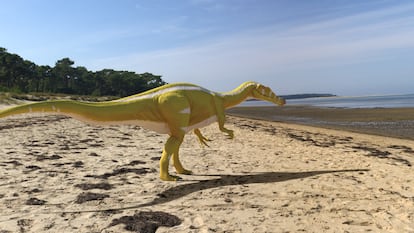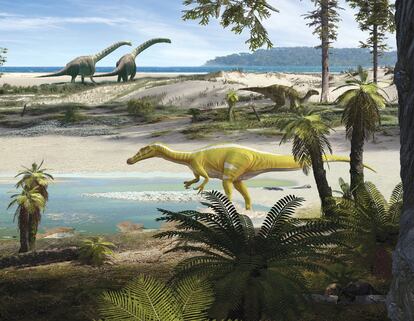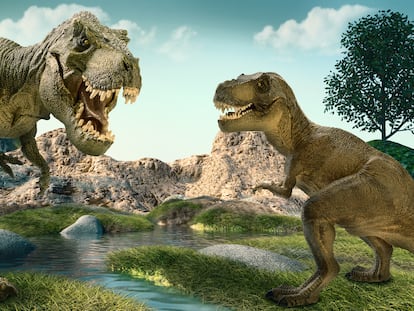The ‘Champion’: Bones of predatory dinosaur found in eastern Spain
The discovery of a potential new species, which has been named in honor of a local soccer club, underlines the rich wealth of fossil deposits from the Cretaceous period in Castellón province

Over 120 million years ago, in the coastal areas of a tropical archipelago of small islands connected by estuaries and marshes in the present-day province of Castellón, in eastern Spain, there was an unprecedented amount of species diversity. In addition to a rich fauna of fish, amphibians, crocodiles, and turtles there were, as far as science is aware, four different groups of dinosaurs — sauropods, theropods, ornithopods and thyreophorans — reptiles that dominated the ecosystem for millions of years in the Early Cretaceous and whose descendants were spread around the Iberian Peninsula, Africa, and Asia, where they diversified into other subspecies. The discovery of the right maxilla and five vertebrae from a single specimen has led researchers to describe what they are calling “a new spinosaurid genus and species”: Protathlitis cinctorrensis. The paper was published in Science Reports, a unit of the same group that publishes the scientific journal Nature.
This previously unknown species has been named by scientists after the Greek word for champion (Protathlitis), and Cinctorres, the town in Castellón where the discovery was made. This carnivorous adult spinosaurid, which measured around 11 meters in length and had an elongated snout and a robust tail, has also been nicknamed “The Champion” due to the Europa League soccer title won in 2021 by Villarreal CF, the biggest club in the province. To underline this source of local pride among the researchers, the presentation of the discovery will take place at Villarreal’s stadium, the Estadio de la Cerámica.
Based on the morphology of their reconstruction, scientists have linked this new dinosaur, which roamed about 127 million years ago, to another large European predator, the fish-eating therapod Baryonyx walkeri. In 2019, Vallibonavenatrix cani, another dinosaur belonging to the same family, was discovered in the same mountain range.

This is the approximate prehistoric snapshot obtained from the eight paleontological campaigns that have been carried out over 20 years at the ANA site in present-day Cinctorres. The vertebrate remains found in the Arcillas de Morella Formation, where the strata dates to the Early Cretaceous, are a real dinosaur quarry, as evidenced by the “nearly 1,000 fossils found at ANA, ranging from small bones to a femur of more than a meter in length belonging to a sauropod,” says paleontologist Andrés Santos-Cubedo, lead researcher of the Protathlitis finding and a scientist at the University Jaime I of Castellón (UJI).
In their research, the scientists suggest that this new species first appeared in Laurasia — the huge landmass in the northern hemisphere that millions of years ago incorporated the areas that today comprise North America and Eurasia — and later migrated to present-day Africa and Asia, where younger spinosaurids have been catalogued. “What happened, why dinosaurs of this family are found in Asia and Africa, is still being debated,” Santos-Cubedo says. “We think that the group originated here, in Europe, and then migrated and diversified from the species that we know of.”
The discovery of a curved and serrated tooth indicates, according to the published paper, that these predators were mainly carnivorous, although it also “allowed them to eat fish” from the coastal shallows, as Santos-Cubedo suggests. At the same time, the arrangement of the jaw gave Protathlitis cinctorrensis a minimum of 16 teeth in their oral cavity. Santos-Cubedo explains that the reason it is common to find numerous dinosaur teeth during excavations is because they were constantly molting, in the same way as sharks: “Behind the functional tooth, another one grew, in a row, so that during their lifetime they changed sets several times,” the paleontologist explains. The ability to replace their teeth was due to the dinosaurs’ carnivorous diet, which damaged and even broke the dental crowns.
These fossil discoveries indicate that Protathlitis and Vallibonavenatrix cani “could have coexisted perfectly well together,” because fossils have been found in the same area and geological formation. As Santos-Cubedo explains: “This is normal. It happens at other sites around the world where more than one dinosaur is found.” The samples found in Castellón were discovered at sites a few miles apart, in different locations, explains the paleontologist.
One of the advantages of the area, and which explains its wealth of well-preserved dinosaur specimens, is the “rapid fossilization of bone remains in the wetlands,” says Ángela Delgado Buscalioni of the Autonomous University of Madrid (UAM). When the dinosaurs died, their skeletons sank to the bottom of the swampy areas and settled without contact with the surface. Hence, the samples were protected from degradation by the elements and now, explains the paleontologist, the bones are excavated — “compacted in the clay-like sandstone” — with almost no effects from erosion.
Delgado Buscalioni, an expert in vertebrate biology who did not participate in the study, says the research provides interesting information regarding the “gaps in scientific knowledge about the variability between [dinosaur] species.” She believes it is possible that “in a later review, synonymy, the grouping of species such as the one in the new discovery,” could occur due to common characteristics with other spinosaurids. But the scientist says the finding “is still interesting because this is how scientific knowledge advances,” even if it eventually transpires that these dinosaurs are grouped under the same name.
For the paleontologist José Miguel Gasulla of the Evolutionary Biology Group at Spain’s National University of Distance Education (UNED), the Iberian Peninsula has “great international importance” in the study of dinosaur fossils and interest in the region “has increased exponentially” in recent decades. The scientist, who has extensive experience in excavations in the Castellón region of Els Ports, says that the existence of dinosaur remains in the area has been known for two centuries.
Gasulla explains that during the “formation of the Iberian mountain range, precisely between the Jurassic and Cretaceous periods, sediments from that epoch were deposited.” That is why in Spanish provinces including Burgos, La Rioja, Soria, and Cuenca, dinosaur footprints have been preserved and large excavation sites established. Paleontology is now in a privileged position in Spain, adds Gasulla, who believes the latest findings will “move research forward” from a scientific point of view.
Sign up for our weekly newsletter to get more English-language news coverage from EL PAÍS USA Edition
Tu suscripción se está usando en otro dispositivo
¿Quieres añadir otro usuario a tu suscripción?
Si continúas leyendo en este dispositivo, no se podrá leer en el otro.
FlechaTu suscripción se está usando en otro dispositivo y solo puedes acceder a EL PAÍS desde un dispositivo a la vez.
Si quieres compartir tu cuenta, cambia tu suscripción a la modalidad Premium, así podrás añadir otro usuario. Cada uno accederá con su propia cuenta de email, lo que os permitirá personalizar vuestra experiencia en EL PAÍS.
¿Tienes una suscripción de empresa? Accede aquí para contratar más cuentas.
En el caso de no saber quién está usando tu cuenta, te recomendamos cambiar tu contraseña aquí.
Si decides continuar compartiendo tu cuenta, este mensaje se mostrará en tu dispositivo y en el de la otra persona que está usando tu cuenta de forma indefinida, afectando a tu experiencia de lectura. Puedes consultar aquí los términos y condiciones de la suscripción digital.
More information
Archived In
Últimas noticias
Most viewed
- Reinhard Genzel, Nobel laureate in physics: ‘One-minute videos will never give you the truth’
- Oona Chaplin: ‘I told James Cameron that I was living in a treehouse and starting a permaculture project with a friend’
- Pablo Escobar’s hippos: A serious environmental problem, 40 years on
- Charles Dubouloz, mountaineering star, retires at 36 with a farewell tour inspired by Walter Bonatti
- Why we lost the habit of sleeping in two segments and how that changed our sense of time










































